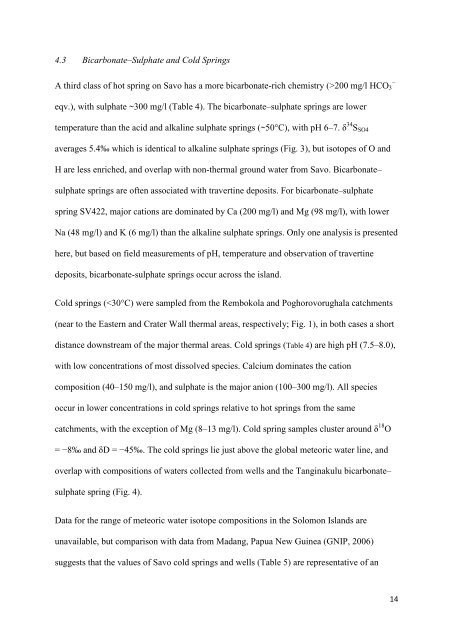Alkaline sulphate fluids produced in a magmatic hydrothermal system
Alkaline sulphate fluids produced in a magmatic hydrothermal system
Alkaline sulphate fluids produced in a magmatic hydrothermal system
Create successful ePaper yourself
Turn your PDF publications into a flip-book with our unique Google optimized e-Paper software.
4.3 Bicarbonate–Sulphate and Cold Spr<strong>in</strong>gs<br />
A third class of hot spr<strong>in</strong>g on Savo has a more bicarbonate-rich chemistry (>200 mg/l HCO 3<br />
−<br />
eqv.), with <strong>sulphate</strong> ~300 mg/l (Table 4). The bicarbonate–<strong>sulphate</strong> spr<strong>in</strong>gs are lower<br />
temperature than the acid and alkal<strong>in</strong>e <strong>sulphate</strong> spr<strong>in</strong>gs (~50°C), with pH 6–7. δ 34 S SO4<br />
averages 5.4‰ which is identical to alkal<strong>in</strong>e <strong>sulphate</strong> spr<strong>in</strong>gs (Fig. 3), but isotopes of O and<br />
H are less enriched, and overlap with non-thermal ground water from Savo. Bicarbonate–<br />
<strong>sulphate</strong> spr<strong>in</strong>gs are often associated with travert<strong>in</strong>e deposits. For bicarbonate–<strong>sulphate</strong><br />
spr<strong>in</strong>g SV422, major cations are dom<strong>in</strong>ated by Ca (200 mg/l) and Mg (98 mg/l), with lower<br />
Na (48 mg/l) and K (6 mg/l) than the alkal<strong>in</strong>e <strong>sulphate</strong> spr<strong>in</strong>gs. Only one analysis is presented<br />
here, but based on field measurements of pH, temperature and observation of travert<strong>in</strong>e<br />
deposits, bicarbonate-<strong>sulphate</strong> spr<strong>in</strong>gs occur across the island.<br />
Cold spr<strong>in</strong>gs (
















